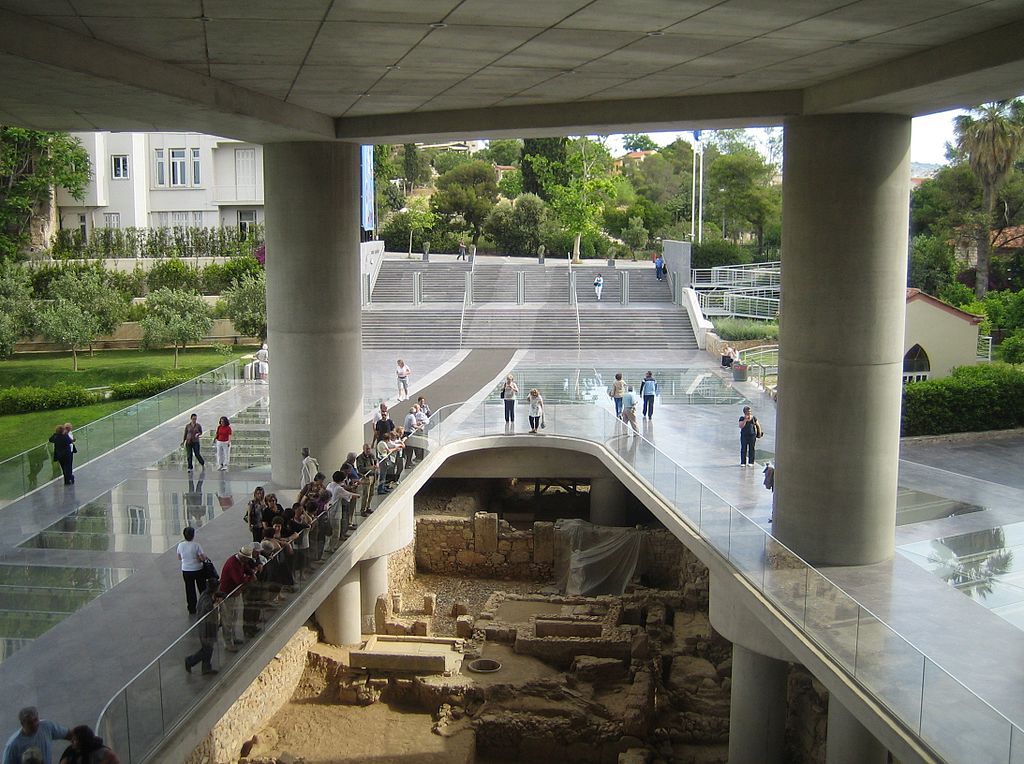
The Acropolis Museum is an archaeological museum focused on the findings of the archaeological site of the Acropolis of Athens.
The museum was built to house every artifact found on the Acropolis and on the surrounding slopes, from the Greek Bronze Age to Roman and Byzantine Greece.
The museum holds over 4,250 objects which are exhibited over an area of 14,000 square meters.
The museum is located by the southeastern slope of the Acropolis hill, on the ancient road that led up to the “sacred rock” in classical times.
Set within walking distance to the Parthenon and built over an extensive archaeological site.
The museum lies over the ruins of a part of Roman and early Byzantine Athens. Visitors can see the excavations below.
The museum also provides an amphitheater, a virtual theatre, and a hall for temporary exhibitions.
Virtual Tour of the Acropolis Museum
- Caryatids of Erechtheum
- Peplos Kore
- Moschophoros – The Calf Bearer
- Kritios Boy
Highlights of the Acropolis Museum
Caryatids of Erechtheum
A Caryatid is a name given to a column that is in the form of a standing female figure. The most famous Caryatids are from the Erechtheion on the Acropolis of Athens.
The Erechtheion is a marble temple building in the Ionic order and was considered the most sacred part of the Acropolis.
At the south porch of the Erechtheion, the roof was supported by six statues of maidens known as the Caryatids. An ancient inscription of the Erechtheion refers to the Caryatids simply as Korai (maidens).
The Greek term karyatides means “maidens of Karyai,” an ancient town of Peloponnese.
Initially, there were six maiden statues. Today at the site, you can only see five. One of the Caryatids was removed by Lord Elgin in 1801 and is today located in the British Museum.
The Caryatids at the Erechtheum on the Acropolis of Athens are copies, as the five remaining originals are in the Acropolis Museum for their protection, conservation, and restoration.
Peplos Kore
The Peplos Kore is one of the most well-known and popular pieces of Archaic Greek art.
Peplos refers to the type of robe or shawl-like fabric draped over the figure, and Kore means a girl or young female.
This white marble statue stands 1.17 cm high, was made around 530 BC and had initially been colorfully painted. The figure was found, in three pieces, in an 1886 excavation near the Erechtheion on the Acropolis of Athens.
Historians and archaeologists debate whether this status is part of the Kori tradition of a mortal girl. Or is she a goddess.
Her eyes are focused on a distant object, and her smile is referred to as the “archaic smile.” The body is sculpted in the round; however, only the front of the body displays fine detail.
Moschophoros – The Calf Bearer
Moschophoros, which is Greek for the “calf-bearer,” is an ancient Greek statue from 560 BC. He stands with his left foot a little forward and has a thick beard, a symbol of adulthood.
The body structure is well built, depicting strength and power. He wears a thin cloak, but the sculpture’s nudity is an essential aspect of the art as it adhered to the artistic conventions of the era. The cloak, on the other hand, depicts him as a respectable citizen.
The calf’s legs are held firmly, making a bold X-shaped composition. This interaction between the calf and the calf-bearer represents a genuine bond between the two. The crossed legs of the calf with the arms of the bearer create unity between them.
Kritios Boy
The Kritios Boy belongs to the early Classical period of ancient Greek sculpture from 480 BC. It is the first statue known to use the contrapposto posture.
Contrapposto is an Italian term that means “counterpoise.” It is used to describe a human figure standing with most of its weight on one foot so that its shoulders and arms twist off-axis from the hips and legs in the axial plane.
With the Kritios Boy, the Greek artist has mastered a complete understanding of how the different parts of the body act as a system.
The statue moves away from the rigid and stiff pose of the Archaic style. Kritios Boy presents a more relaxed and naturalistic posture known as contrapposto.
This stance forces a chain of anatomical events. As the pelvis is pushed diagonally upwards on the left side, the spine acquires an “S” curve, and the shoulder line dips on the left to counteract the action of the pelvis.
The Acropolis Museum
- Name: Acropolis Museum
- Greek: Μουσείο Ακρόπολης
- City: Athens
- Country: Greece
- Established: 2009
- Type: Archaeological Museum
- Collection: 4,250+ objects
- Location: Dionysiou Areopagitou Street, Athens, Greece
- Transit access: Akropoli
Explore Museums in Athens
- Acropolis Museum
- National Archaeological Museum
- Benaki Museum
- Goulandris Museum of Cycladic Art
- Byzantine and Christian Museum
- Hellenic Motor Museum
- National Historical Museum, Athens
- Museum of the Ancient Agora
- Syntagma Metro Station Archaeological Collection
- Numismatic Museum of Athens
- Athens War Museum
- Jewish Museum of Greece
- Athens University Museum
Map for The Acropolis Museum
A visit to the Acropolis Museum
A Visit to the Acropolis Museum
Acropolis Museum, Athens, Greece
~~~
“You don’t develop courage by being happy in your relationships every day.
You develop it by surviving difficult times and challenging adversity.”
– Epicurus
~~~
Photo Credit:By Tomisti (Own work) [CC BY-SA 3.0 (http://creativecommons.org/licenses/by-sa/3.0)], via Wikimedia Commons
Popular this Week








 Sponsor your Favorite Page
Sponsor your Favorite Page SEARCH Search for: Search Follow UsJoin – The JOM Membership Program
Sponsor a Masterpiece with YOUR NAME CHOICE for $5
Share this:
- Tweet
